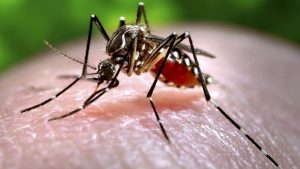This post was written by Andrew Hennessy-Strahs, a 2017 Global Health Law LL.M. Candidate at Georgetown University Law Center. Any questions or comments can be directed to adh75@georgetown.edu.
 While the Western Hemisphere has largely turned its attention to the Zika epidemic, another far-more-lethal epidemic is ravaging West Africa, largely unchecked just across the Atlantic. Moreover, this is hardly a new virus; the international community has had an effective, cheap vaccine for nearly seven decades.
While the Western Hemisphere has largely turned its attention to the Zika epidemic, another far-more-lethal epidemic is ravaging West Africa, largely unchecked just across the Atlantic. Moreover, this is hardly a new virus; the international community has had an effective, cheap vaccine for nearly seven decades.
In December 2015, plummeting oil prices devastated the oil dependent economy of Angola. The financial distress, in turn led to a reduction in public sanitation services in an effort to stabilize the budget. The buildup of garbage then created optimal breeding grounds for the pathogenic mosquito viral vectors, which lay their eggs in water. As the mosquitoes proliferated, Luanda, the capital of Angola began seeing an unprecedented number of yellow fever cases that signaled the beginning of a new epidemic. A distrust of the medical system from the populace within the borders of Angola, combined with a suspicion of the international health community by Angola’s authorities has raised cries that the global health community is repeating the mistakes that catalyzed the Ebola epidemic in 2014. At least 6,000 suspected and confirmed cases have been reported to date, with at least 369 deaths.
Complicating matters from a public health standpoint, Angola failed to timely report the growing epidemic to the international authorities, and thus missed a crucial window to identify so-called “chains of transmission,” which would enable medical personnel to strategically vaccinate vulnerable people who are more likely to contract the virus. Although there were enough vaccines to adequately counteract the epidemic, had transmission chains been identified and pursued, Angola and other authorities decided to arbitrarily vaccinate. Twenty million vaccines arrived in Angola. At least one million vaccines went missing, and of the remaining nineteen million, many arrived without refrigeration or proper syringes.
Nearly three years ago, however, in November of 2013, UNICEF issued a report on the yellow fever vaccine, anticipating that supply of vaccine would not be sufficient to meet demand for the vaccine between 2014-2017. UNICEF cites as reasons, the increase of the weighted average drug price 30% per year from $0.20/dose in 2000 to $0.95/dose in 2013, and the suspension of one of the four manufacturers from WHO prequalification supply. UNICEF also forecasted a demand for vaccine between 2014-2017, of 62 million doses. This exceeded the forecasted supply by 44%.
Due to the lack and mismanagement of vaccines, the yellow fever virus has just crossed the border into Congo. Because the vaccination program was ineffective in Angola, it is likely to be even more futile in Congo, as Congo is significantly more populous and globally connected than Angola.
The way yellow fever kills and spreads is not merely significant on its own, but is a case study in the types of epidemics we already face and will continue to confront. Yellow fever is a tropical, hemorrhagic flavivirus, belonging to the same genus as Dengue virus, West Nile virus and Zika virus. There are two stages of yellow fever infection. While many people do not experience symptoms during the first stage, the symptoms are relatively mild, including fever, muscle pain, backache, headache, loss of appetite, nausea and vomiting. After resolution of the first stage, about fifteen percent of patients enter a second, more lethal phase, in which kidney and liver damage occurs. This phase may include jaundice, as the liver fails and is unable to breakdown bilirubin, thus causing a yellowish tinge to the skin and eyes. Bleeding can occur from the mouth, nose, eyes, or stomach (similar to the symptoms caused by another hemorrhagic virus, Ebola). Half of all patients who enter this second phase will die within 7-10 days. Yellow fever is transmitted by two types of mosquito vectors, Aedes aegypti and Aedes albopictus, meaning that these mosquitoes must bite an infected person and can then retransmit the virus when they bite an uninfected person. These mosquitoes also transmit Dengue fever, and Chikungunya, but not malaria. Forty seven countries in the world either are endemic in their entirety for yellow fever or have regions endemic for yellow fever. Thirty four of these countries are in Africa and thirteen are in Central and South America.
On Wednesday, August 17, 2016, however, a program was unveiled to give 15.5 million people 1/5 doses of the vaccine in order to provide partial immunity. The immunity will last one year as opposed to a lifetime. To date, 7.7 million people have received these fractional doses.
On August 31, 2016, the World Health Organization declared that the Yellow fever epidemic is not a Public Health Emergency of International Concern, citing progress on the fractional dose strategy. Alas, public health workers are also facing the prospect of a rainy season, beginning in September in this region of West Africa, which could exacerbate efforts to prevent mosquito-borne transmission, due to the explosion in mosquito populations. Hopefully, the World Health Organization has made the correct assessment and we are not merely buying time with fractional doses, but substantively resolving the epidemic as part of a comprehensive strategy. And maybe, just maybe, we can apply the lessons we are learning to other tropical disease epidemics as they continue to surface and to resurface.



